
Image: Hayden Dingman / IDG
If you want to be competitive in PC games these days, you can forget about using a run-of-the-mill office mouse. Instead, you’ll need a powerful device that’s optimized just for gaming.
Manufacturers go to great pains to design specialist devices that give players an edge, with enhancements like unique body sizes and shapes, customizable weight, and extra grips to increase speed and accuracy. On top of that, the best gaming mice have unique hardware enhancements like highly sensitive sensors and complex button configurations to keep up with fast-paced games.
Deciding on the right mouse is a highly personal decision that needs careful consideration. Factors like the size and shape of your hand, your preferred grip style, the types of games you play, and the number of buttons you need, are all factors in your quest for the best gaming mouse.
PCWorld reviewers have done the hard part for you, testing the heck out of scores of gaming mice, to present a list of the very best gaming mice in a variety of categories. For more on how they were selected and further buying advice, see below our list of recommendations.
Updated 11/21/23 to include the Razer Viper V3 Hyperspeed as our pick for best dual-purpose gaming and productivity mouse. This mouse’s killer 30,000 DPI Razer Focus Pro Optical Sensor and quick Razer Gen 2 Mechanical Switches make it ideal for esports, yet its modest uni-color black casing means it’s stealthy enough for work or study, too. Scroll below to learn more about this mice and our other top picks.
Logitech G502X – Best wired gaming mouse / Best overall
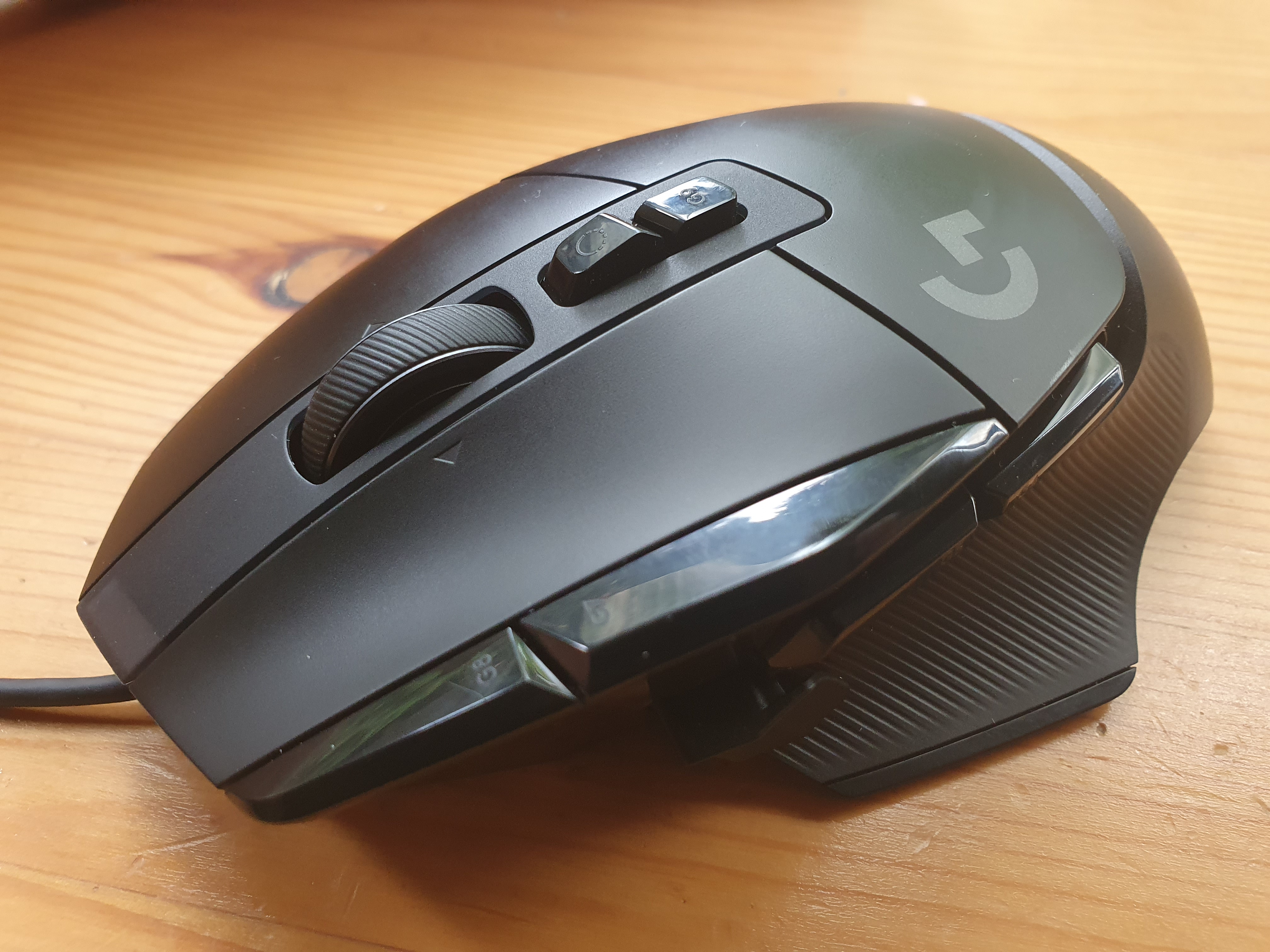
Pros
The 25K Hero sensor is very proficient even at high DPI settings
The buttons are extremely well placed for accessibility
The rubber thumb rest provides plenty of grip
Cons
Not including swappable trigger buttons seems like a missed opportunity
There’s no RGB lighting except a small DPI indicator light
The mouse wheel is quite noisy
The Logitech G502, which so wowed gamers back in 2014 has evolved into a new model, the Logitech G502X, which boasts several big improvements over its predecessor. These include: a higher-resolution 25K sensor, a new rubberized thumb grip, and lightning-fast hybrid optical-mechanical switches.
Admittedly, its 89-gram weight means it’s not the lightest gaming mouse on the market. However, any concerns about performance fall by the wayside because of the larger and more accessible buttons. You still get 13 programmable options, including the side trigger button and DPI buttons cut into the left main click, but the trigger is now closer to your thumb and easier to reach, and the DPI buttons are longer and harder to misclick. This ultimately means the G502X has arguably the best all-rounder button setup you can get.
Read our full
Logitech G502X review
Cooler Master MM830 – Best budget wired gaming mouse

Pros
Incredibly comfortable and durable
Top-tier performance, with a PMW3360 sensor
You can put a gun on your mouse, I guess
Cons
D-pad is largely the same as any other thumb buttons
OLED screen is superfluous at best
PWM3360 cranked to 24,000 DPI for no reason
The MM830 differentiates itself from other budget gaming mice with fun features like a built-in D-pad and tiny OLED display that you can set up to show information like your RAM, CPU, and GPU usage stats. But looking beyond these novelties, it also performs well in games, which is infinitely more important. Powering that performance is a top-end 24,000 DPI PMW3360 sensor, which for comparison’s sake, is the same as the premium Logitech Hero sensor just with a higher power draw.
On top of the mouse’s body the MM830’s sports a textured plastic exterior that provides plenty of grip for your hand. A gentle right-hand scoop also makes it incredibly comfy to use even for long gaming stints.
Read our full
Cooler Master MM830 review
Logitech G203 LightSync – Best ultra-budget gaming mouse
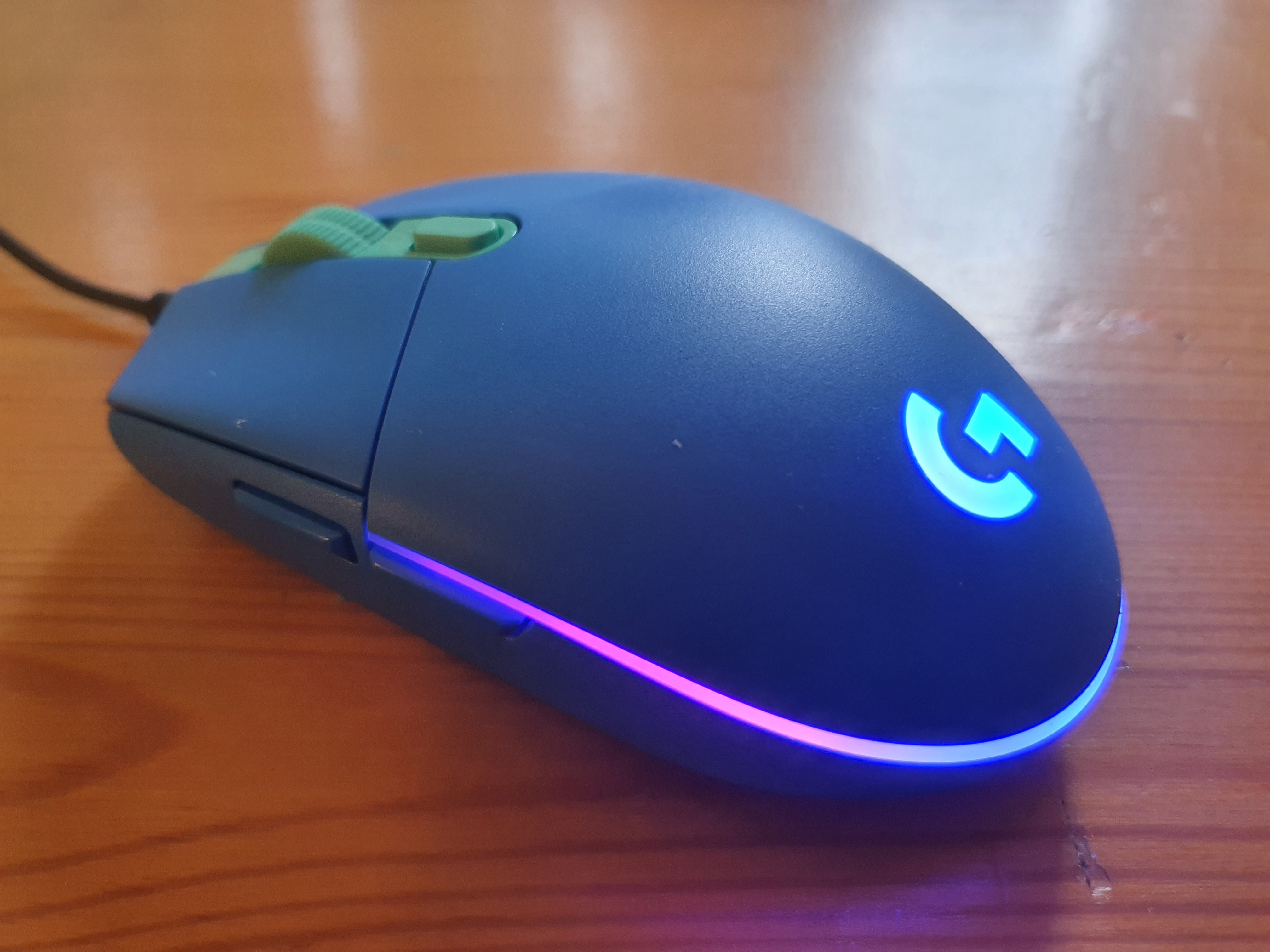
Pros
A comfortable design that resembles more expensive esports mice
Sturdy and well-built
The RGB lighting really pops
Cons
Some sensor lag was experienced with large, fast movements
The sensor’s lift-off distance is higher than some mice
The RGB logo on the top isn’t customizable
Few devices offer as much bang for buck as this wired RGB gaming mouse that combines comfort, style and decent performance but without a hefty price tag. The Logitech G203 resembles more expensive esports mice with its simple 6-button configuration, small body and ambidextrous shape, but despite being substantially cheaper than rivals, it still feels sturdy and well-built. The G203’s 8,000 DPI sensor isn’t the quickest you’ll find, but for causal gamers it’s still a more than adequate performer that tracks accurately.
The G203 isn’t lacking style either. It features a signature rounded back design with colorful RGB band and Logitech logo that lights up your gaming den with pops of color. The RGB band is also customizable in the Logitech G Hub app, with the option to personalize three separate lighting zones.
Read our full
Logitech G203 LightSync review
Razer Cobra Pro – Best wireless gaming mouse
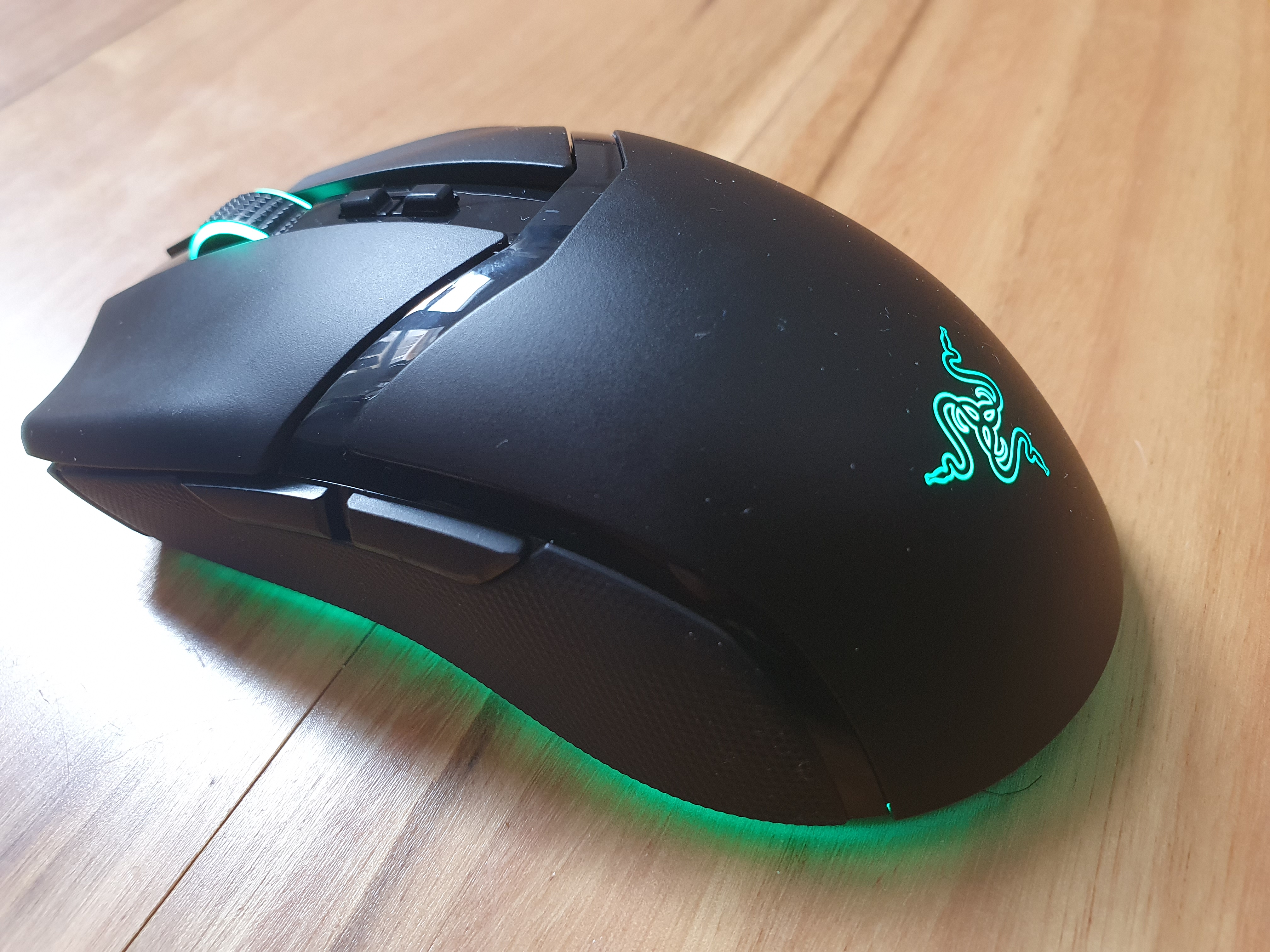
Pros
Its Razer Focus Pro 30K sensor is superb
Dedicated DPI up/down buttons makes switching DPI on the fly easy
Having 11 zones of RGB is brilliant
Cons
The dimensions won’t suit large hands
Buying the Cobra Pro with a Hyper polling dongle costs extra
It’s a little heavier than its stablemate the Razer DeathAdder V3 Pro
The Razer Cobra Pro is an excellent all-round gaming mouse with a very sensitive 30K sensor that will give the best esports mice a run for their money. While its 79-gram weight makes it a little heavier than many competitive FPS mice, it boasts features that most don’t have. Indeed, features like its up / down DPI buttons that allow you to switch DPI on the fly, its gorgeous 11 zones of RGB lighting and Tri-Mode connectivity (wired, 2.4GHz Wi-Fi, and Bluetooth) make it a highly versatile and sought after gaming mouse.
Its one drawback, however, is its compact size, which comfortably fits small to medium sized hands but is a little too small for some large hands. Of course, this won’t affect players who prefer to use a claw grip, so this mouse is especially suited to them.
Read our full
Razer Cobra Pro review
HyperX Pulsefire Haste 2 Wireless – Best budget wireless gaming mouse

Pros
The solid top back is comfortable and stylish
The 26,000 sensor can target at lightning speeds
Bluetooth functionality makes it one of the most versatile esports mice you can get
Cons
The compact buttons can feel a bit cramped at times
There’s just one RGB zone to play with
It’s more expensive than its predecessor
The HyperX Pulsefire Haste 2 Wireless features a lightning-fast 26,000 DPI sensor, Bluetooth and 2.4GHz wireless connectivity, as well as a dedicated DPI switcher and still manages to be lighter and more affordable than some rivals. It weighs just a little over 2 ounces (61 grams), which is ideal for fast competitive gaming and esports. Its generous proportions and easy six-button configuration are just ideal to fit medium- and large-sized hands.
This mouse’s solid plastic casing is also a lot more comfortable for claw and fingertip grippers than its predecessor — the HyperX Pulsefire Haste Wireless, which has perforated casing. Price-wise, you’d expect to pay more than $100 for an esports/FPS mouse of this caliber, but the HyperX Pulsefire Haste 2 Wireless currently costs just $54 at Amazon.
Read our full
HyperX Pulsefire Haste 2 Wireless review
Mad Catz R.A.T. 8+ – Best gaming mouse for tinkerers

Pros
Eminently customizable
Uses a reliable PMW3389 sensor
Feels durable
Cons
Customization options aren’t always intuitive
Heavy, even with the weights removed
Hard to know whether Mad Catz peripherals are the more reliable nowadays
The Mad Catz R.A.T 8+ is about as customizable as gaming mice come, featuring a modular design that allows you to change up its component parts exactly as you wish to find your ideal mouse shape and weight. Doing so requires you to pull discrete levers and turn knobs integrated into the mouse’s body, so there’s a fairly steep learning curve before you know what you’re doing.
Still, if you love tinkering, this mouse will keep you entertained for hours at a time. It also doesn’t skimp in the button department, providing 10 buttons all told, orientated in some pretty original positions for extra convenience. With a stripped-back, bare-bones look, the Mad Catz R.A.T 8+ also stands out in the crowd, making it an obvious talking point at any group gaming sessions.
Read our Mad Catz R.A.T 8+ review
Razer Naga V2 Pro – Best gaming mouse for MOBA and MMO games

Pros
The swappable button plates let you tailor your button setup to your game’s command load
The sensor is very accurate and without a hint of lag
There’s tons of comfort and the build quality is excellent
Cons
The Razer Gen 3 Optical Switches are a little stiff at first and need wearing in
It weighs 134 grams which is quite heavy even for an MMO mouse
It’s currently very expensive
The Razer Naga V2 Pro does one better than just let you program your buttons how you like them—it features three swappable side-button plates that you can change out to tailor your mouse’s physical button setup to your game’s command load. Consequently, it makes a great all-around gaming mouse. In my playtesting I found it was especially perfect for MOBA and MMO games since you get a total of 22 commands with the 12-button plate attached, so there’s lots of options.
As well as a very comfortable design, the V2 Pro also sports an accurate and precise 30,000 DPI sensor and Razer Gen 3 Optical Switches in the buttons that actuate in just 0.2 milliseconds. In our review, its 134-gram weight made it a little heavy for achieving top performance in FPS games, but in MMO games this extra weightiness made weapons play feel extremely authentic and highly satisfying.
Read our full
Razer Naga V2 Pro review
SteelSeries Aerox 9 Wireless – Best gaming mouse for MOBA and MMO games runner-up

Pros
18 easily programmable buttons
Weighs only 89 grams
Quick and responsive
Dual Bluetooth 5.0 and 2.4GHz wireless
Cons
Some buttons on the side grid are hard to reach
The more buttons, the heavier and slower gaming mice tend to be, but the SteelSereis Aerox 9 bucks this trend with a whopping 18 buttons and weighing just 89 grams. Needless to say, having 18 buttons at your disposal rather than 6, 8 or 12, gives you a little more firepower to launch commands and macros in games where quick deployment is needed—especially in MMOs and MOBAs like The Elder Scrolls Online or Final Fantasy XIV.
On top of the generous button selection, the Aerox 9 features a quick 18,000 DPI sensor and dual 2.4GHz Wi-Fi and Bluetooth connectivity, so it’s highly versatile and portable. Design-wise, the Aerox 9 looks and feels fantastic thanks to a futuristic honeycomb-shaped back with RGB lighting. Additionally, since it weighs under 100 grams, it’s fast enough to keep you competitive in first-person shooters.
Read our full
SteelSeries Aerox 9 Wireless review
Razer Basilisk V3 – Best mouse wheel / Best for scrolling
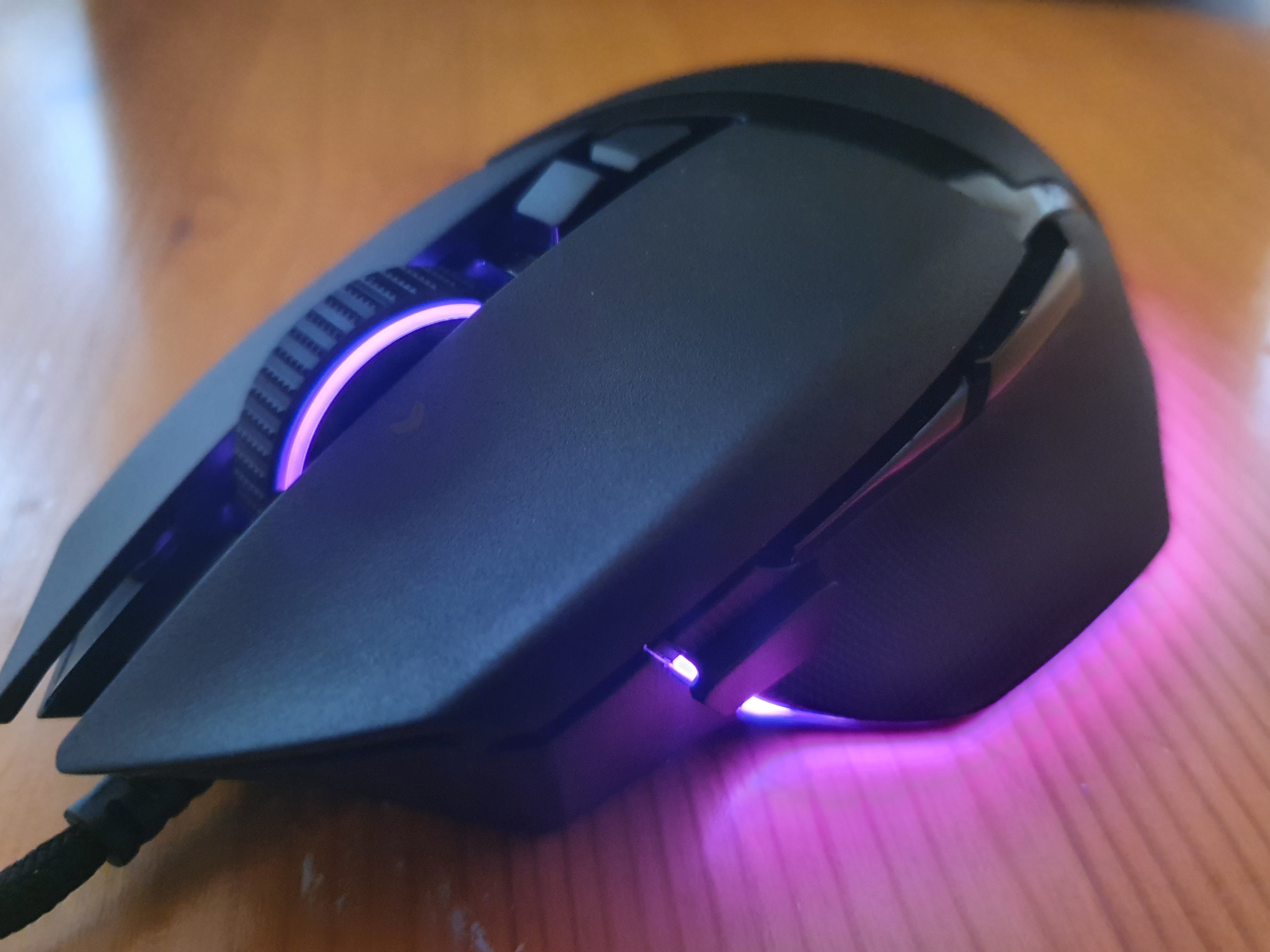
Pros
The Razer Focus + sensor gives faultless performance
Scrolling is made simpler with the HyperScroll Tilt Wheel
The RGB lighting looks fantastic
Cons
It’s quite heavy and bulky
You’re limited to wired connectivity only
The Basilisk V3 resembles the Razer Basilisk V2 in size and shape, sporting similar right-handed curves and a slightly arched thumb rest. Among its best features are an 11 button layout, 26,000 DPI Razer Focus+ sensor, and second-generation Razer optical switches that are fast enough for all kinds of gaming—whether that’s casual or serious. But the real magic lies in the Basilisk V3’s HyperScroll Tilt Wheel, which is a fancy name for its mouse wheel. This tilts in four directions and triggers downwards to put five commands at your fingertips, ideal for tactical FPS games like Rainbow Six.
Impressively, the HyperScroll Tilt Wheel also has extra AI scrolling modes that make your scrolling and browsing a lot easier. In our testing we enjoyed toggling between “Tactile” and “Free-Spin” modes, which allowed us to switch between a slow, precise scrolling action and a faster, smoother scrolling action that was useful for getting to the end of long websites more easily.
Read our full
Razer Basilisk V3 review
ROG Harpe Ace Aim Lab Edition – Best gaming mouse for esports / first-person shooters

Pros
36,000 DPI sensor is extremely sensitive and accurate
Weighs just 54 grams
Tri-Mode connectivity means it’s highly versatile
Cons
Buttons aren’t very audible
Left side buttons are a little small
No 4000Hz HyperPolling
This mouse is the result of a collaboration by two big names in pro gaming: Asus’s ROG brand and the aim trainer, Aim Labs. Suffice to say, pro gamers have had a huge amount of input into its design and it really shows. To achieve a lofty 54 grams — just ideal for esports — it features a symmetrical body made out nylon instead of plastic. You wouldn’t know that from using it, though, since it feels remarkably tough and grippy.
The hardware too is expertly primed for pro gamers. Despite its ultra-light weight, the Harpe Ace Aim Lab Edition features all three connectivity types — wired, low-latency Wi-Fi, and Bluetooth — so that you have the convenience of the lowest-latency connection when you want it and the versatility of wireless connectivity to use it anywhere. Additionally, its 36,000 DPI sensor is one of the quickest and most accurate we’ve used.
The Harpe Ace Aim Lab Edition’s design will comfortably fit all hand types — from small to large. That said, some gamers with large hands may find its rather small left side buttons a little hard to reach.
Read our full
ROG Harpe Ace Aim Lab Edition review
Razer DeathAdder V3 Pro – Best for esports / first-person shooters runner-up
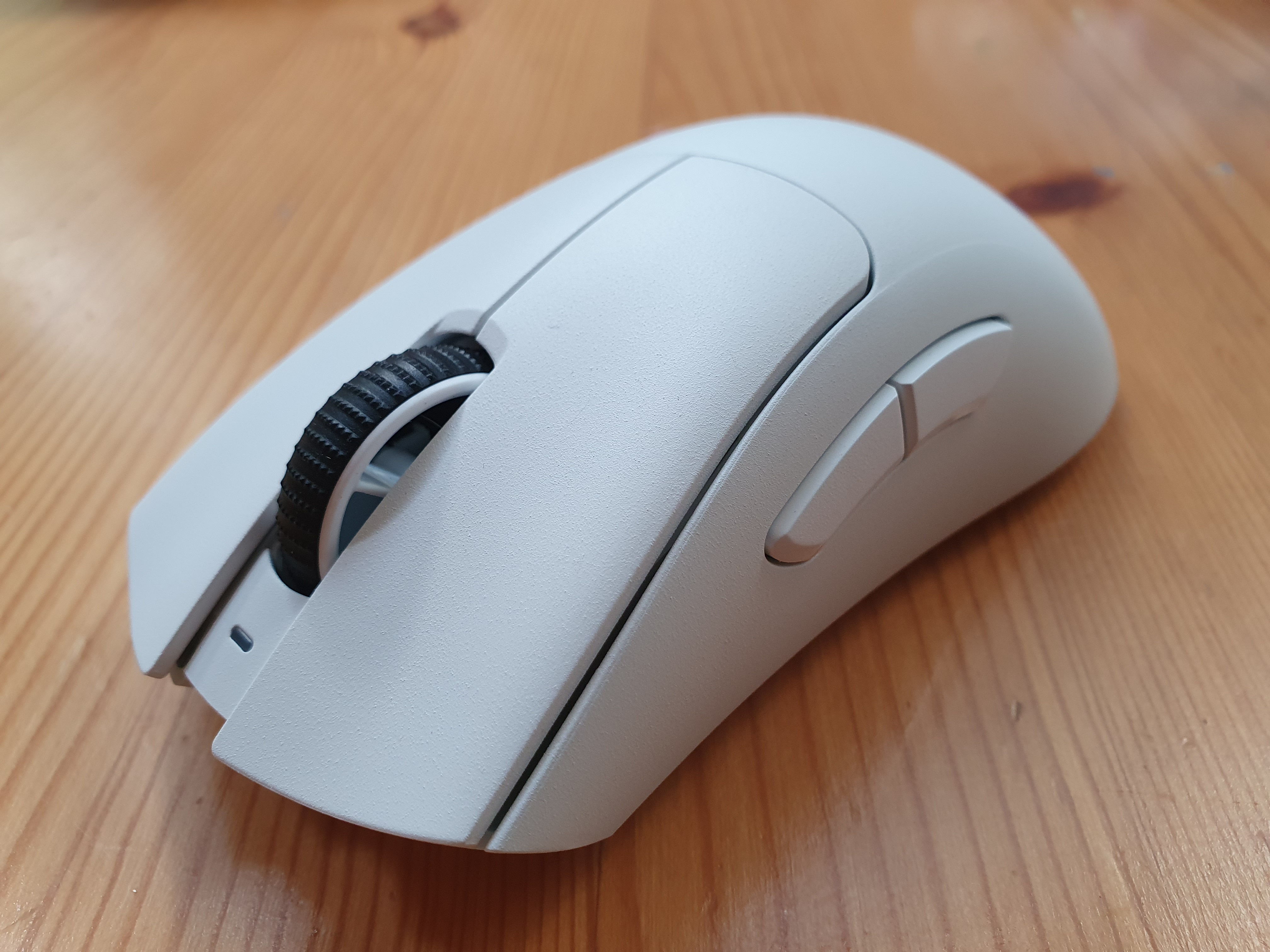
Pros
Ultra light and quick off the mark
Perfectly chiseled to the contours of your hand
The 30,000 DPI sensor is very impressive
Cons
It’ll cost you extra to upgrade to 4,000Hz hyper polling
Has fewer buttons than its predecessor
DPI button is located on the underside
Weighing just 63 grams, the five-button DeathAdder V3 Pro is ultra-lightweight and exceptionally quick off the mark in FPS games. It also sports a symmetrical streamlined body that fits perfectly into the contours of any medium to large hand. But what really sets it apart, is its pro-grade 30,000 DPI optical sensor, the likes of which you’d be hard pressed to find an equal. The V3 Pro’s sensor not only tracks your movements flawlessly, but it’s also capable of hyper polling up to a whopping 4,000Hz.
You can also set a lift-off and landing distance to one of 26 granular levels, which is 23 more than what you get in many rivals. Admittedly, as good as it is, there are still a few drawbacks. The DPI button is located on the underside, which means changing DPIs on the fly can be a little slow, and for the privilege of hyper polling you’ll need to purchase a Razer HyperPolling dongle for an additional $29.99. Still, with the V3 Pro you’re getting a top-notch device that will serve you extremely well when the heat is on.
Read our full
Razer DeathAdder V3 Pro review
ROCCAT Burst Pro Air – Best RGB gaming mouse

Pros
Owl-Eye sensor is very precise and quick
You won’t find a mouse with more stunning RGB lighting
Dual wireless as well as wired connectivity
Cons
81-gram weight can feel heavy if you’re used to a lighter mouse
Mouse wheel lacks left and right lateral clicks
Pricey compared to some rivals
The ROCCAT Burst Pro Air’s four dedicated RGB lighting zones shine colored light through its semi-transparent body, creating a mesmerizing sheen-like glow that looks totally stunning from any angle. If the semi-transparent shell is your canvas, then ROCCAT’s Swarm app provides your painter’s palette, letting you go to town customizing each zone with up to 16.8 million colors and a range of stunning effects.
But as any gamer knows, looks aren’t everything. Consequently, we also chose the Pro Air because of its excellent gaming performance, which in our play testing we attributed to its comfortable eight-button design, powerful 19,000 DPI Owl-Eye optical sensor, and low-latency optical switches, which are rated for 100 million clicks.
The Pro Air also scores big points for its excellent connectivity options, which includes low-latency 2.4GHz Wi-Fi and Bluetooth 5.2 wireless options, and a USB-A to USB-C cable for wired connectivity. For another great ROCCAT gaming mice that has previously taken top position for ‘Best RGB gaming mouse’ also check out the ROCCAT Kone XP.
Read our full
ROCCAT Burst Pro Air review
Cherry Xtrfy M8 Wireless – Most original gaming mouse design
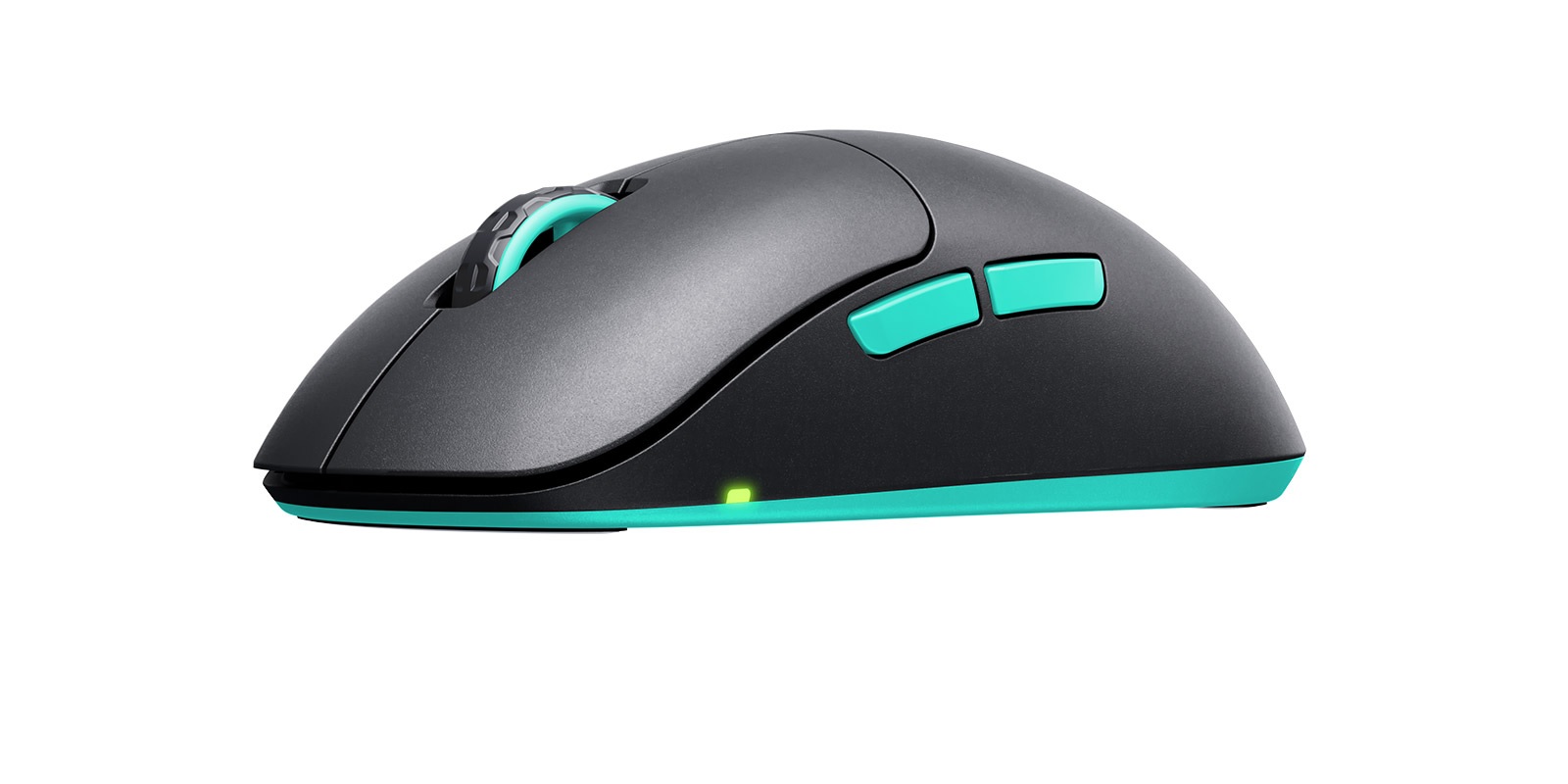
Pros
Very good sensor
Ultra-flat front
Very light
Eco-friendly design
Long battery life
Cons
Unusually placed charging socket
Design might take some getting used to for some users
The Xtrfy M8’s design is as unique as possible, with the charging socket placed on its right-side rather than at the front like just about every other gaming mouse you will find. But while some players may like that and others not so much, what we salute the most in its design is the fact that its housing is made from 60 percent recycled plastic.
Despite the reused materials, this mouse’s hardware is just perfect for pro-gamers. It’s powered by a Pixart 3395 sensor with a maximum resolution of 26,000 DPI. A low-latency 2.4GHz Wi-Fi signal provides a response time as fast as 1 millisecond. If changing debounce is your jam, the M8 also allows you to choose between four settings: 2, 4, 8, or 12 milliseconds. Plus, it weighs just 55 grams which makes it one of the lightest and quickest mice you will move over your mouse mat.
Read our full
Cherry Xtrfy M8 Wireless review
Razer Viper V3 Hyperspeed – Best dual-purpose gaming and productivity mouse

Pros
Quick and accurate sensor
High sensor positioning
Very long battery life
Cons
No RGB lighting
2.4GHz Wi-Fi connectivity only
Weighs less than 3 ounces
Price When Reviewed:
72,99 Euro
With no RGB lighting and a modest uni-color Black casing, the Razer Viper V3 Hyperspeed is stealthy enough to be your work or study mouse, and yet it also has some of the best hardware for esports you can find in a wireless mouse. That includes a whopping 30,000 DPI Razer Focus Pro Optical Sensor and super-quick Razer Gen 2 Mechanical Switches.
The Viper V3 Hyperspeed’s design gives you precision control of your movements; it features a high back and lots of length in the fingers so that you can stretch out in a palm grip. The high position of the sensor catches your movements at their origin for split-second quicker movement than we’ve experienced in some rivals. The Viper V3 Hyperspeed also supports 4,000Hz HyperPolling, which really makes this mouse cook with fire in fast action games like CouterStrike — although you will have to shell out $29.99 extra for the HyperPolling dongle (not included). The Viper V3 also has excellent battery life. In fact, a single AA battery provides up to 280 hours of operation at the mouse’s default polling rate of 1,000Hz.
The V3 Hyperspeed currently costs $69.99 at Razer, Amazon, and Best Buy. In a similar vein but with more modest hardware and for $15 cheaper, be sure to check out the Razer DeathAdder V2 X Hyperspeed too.
Read our full
Razer Viper V3 Hyperspeed review
MSI Clutch GM51 Lightweight Wireless – Best rechargeable gaming mouse

Pros
Charging dock included
Current high-end sensor from Pixart
Omron switches
Three connection modes (2.4GHz, Bluetooth, wired)
Good price-performance ratio
Cons
A bit heavy for “Lightweight”
Software is a little convoluted
Price When Reviewed:
106,21
The MSI Clutch GM51 Lightweight Wireless gaming mouse combines practicality, functionality, and stellar looks better than just about any other gaming mouse. As well as supporting all three connectivity types — 2.4GHz Wi-Fi, Bluetooth, and wired — it features visually striking RGB Diamond Lightgrips down each side that hold your fingers to the mouse’s body and provide you with a lot of precision control over movement. Another practical feature is the convenient charging dock that makes recharging a piece of pie and means it’s very difficult to ever run out of battery.
The GM51 Lightweight Wireless has impressive hardware for gaming, including a Pixart PAW 3395 sensor with a maximum resolution of 26,000 DPI and Omron switches in its buttons, which are known for their durability and speed. Although its 89-gram weight is at the upper end of what many would call lightweight, its balanced size makes it especially comfortable for palm and claw grips.
Read our full
MSI Clutch GM51 Lightweight Wireless review
How we test gaming mice
To ensure that our gaming mice selections are the pick of the crop, the PCWorld team subjects them to extensive play testing as well as a legion of other tests. We scrutinize everything from how well a mouse perform in games, to the size and shape of it in the hand, to comfort and ergonomics, to customizations. Here are the main categories our tests fall under:
Gaming performance: At the end of the day it doesn’t matter how a mouse looks; it’s how it performs that matters. To evaluate a mouse’s performance we look specifically at how sensitive and responsive its sensor is and also how well the sensor tracks movement. Precision is also a key consideration, with mice that are more accurate generally scoring better in our reviews than those that aren’t. In wireless mice we also evaluate the speed and strength of the Wi-Fi and Bluetooth signals, keeping a look out for red flags like signal dropouts or interference. Some mice also come with software enhancements that determine the mouse’s lift-off distance, which we also examine in our testing.
Design and ergonomics: You won’t find another tech device for which design plays a more crucial part of a user’s experience. And, while it’s true that there’s no one shape, size, or configuration that fits every gamer, there’s enough variation out there for every gamer to find their own perfect fit. When looking at design, we consider the size and shape of the device itself and the type of hand it fits. Gamers tend to use one of three common grip types—palm, claw, or fingertip—so a mouse’s compatibility with one or all of those types is a big consideration.
Software: Being able to tweak settings like your mouse’s DPI and polling rate and create specific profiles for your favorite games can make or break your gaming experience, which is why a mouse’s software support is so important. Our PCWorld reviewers’ focus here is to consider the range and scope of software support and how readily settings can be modified, changed, and saved for future use.
FAQ
1.
Should I choose a wired or wireless mouse or one with both connectivity types?
It used to be generally well accepted that wired gaming mice had the edge over their wireless counterparts, providing gamers with a much faster and more accurate signal between mice and PCs. However, that’s less true today thanks to the popularity of 2.4GHz Wi-Fi and Bluetooth wireless technologies, which have almost levelled the playing field.
I say almost, because there’s no denying that wired gaming mice still deliver the fastest and most secure connections you can get. That said, whether you choose one type over the other should come down to your gaming priorities.
If you’re a serious competitive gamer or esports player, where winning or losing sits on a knife’s edge, opting for a wired mouse over a wireless one is a good decision, since it’s less likely a signal dropout or interference will disrupt your play. Every competitive edge counts. However, wireless mice are infinitely more portable and allow you to switch between devices at a whim, so if nimbleness and portability is more important, a wireless mouse will be a better fit.
2.
What size and shape mouse should I get?
Hands, just like gaming mice, come in all different shapes and sizes, and for comfort reasons it pays to match like with like. While categorizing sizes of hands can be highly subjective, chances are you’ll be able to guess whether your hand is on average small, medium, or large. You can then find a mouse that best fits from among the size categories below:
• Small gaming mouse: Length: Less than 6.7 inches; width: 2.9 to 3.3 inches
• Medium gaming mouse: Length: 6.7 to 7.9 inches; width: 3.3 to 3.9 inches
• Large gaming mouse: Length: 7.9 inches; width: 3.9 to 4.3 inches
Gaming mice generally come in three shapes: left-handed, right-handed, and ambidextrous. Ambidextrous mice are designed to be neutral in that they can be just as easily used by your left or right hand. Alternatively, left-handed and right-handed mice are tailor-made for the dominant hands specified by their namesakes, often sporting bespoke curves and button placements for one or the other. Unless you switch between hands, using a gaming mouse that matches your dominant hand will go a long way to improving your performance and comfort.
Your preferred grip type should also be considered when selecting a suitably shaped mouse. Here’s a rough guide for matching grip types with mouse shapes:
• Palm grip: Long, flat mice tend to be a better fit and more comfortable
• Claw grip: Narrower and smaller mice tend to suit this grip style
• Fingertip grip: Lighter mice are often preferred by fingertip grippers to reduce strain
3.
How light should my mouse be?
Gaming mice weights have been gradually trending downwards over the years as players look for lighter options that are quicker to move and prevent arms and wrists getting overly tired or sore in long play sessions. FPS (first-person shooter) gamers in particular tend to go for the lightest mice possible, seeing every millisecond of speed advantage as worth chasing.
Despite this, there’s no ideal gaming mouse weight for all gamers, but rather a deeply personal preference. In fact, some gamers—often those with larger hands or stronger arms—actually prefer heavier mice for the extra stability they get. Still if you are one of those looking for the lightest mouse possible, anything under 70 grams will be among the lightest on the market.
4.
Does DPI really matter on a gaming mouse?
Your mouse’s sensor is the essential hardware component that relays movement to your PC. Mice sensors are rated for DPI, or dots per inch, which tells us how far a cursor moves per inch of mouse movement—that is, how sensitive it is. Manufacturers really hype up the importance of high DPIs, which can be a bit misleading because they don’t necessarily equate to better gaming performance (they can, but not in all circumstances).
For example, if you play a lot of FPS and want the absolute best accuracy while targeting opponents, a lower DPI (between 800-1,000) is preferable, since this allows you to make short, sharp, and precise movements more easily. However, if you make a lot of wide, sweeping hand movements, or if your display is a very high resolution, a mouse with a high DPI (between 12,000-30,000 DPI) can be an advantage.
The great thing about most modern gaming mice is that they can switch between DPI profiles just by clicking a small button behind the mouse wheel. That said, our advice is to opt for a gaming mouse with the highest DPI your budget allows, and then choose your preferred setting for different gaming scenarios by using this handy DPI-switching feature.
5.
Is an optical or laser sensor better for a gaming mouse?
Optical sensors are the most popular with gamers since they tend to have less jitter and smoothing problems. These sensors work by casting down infrared or LED light onto your mousepad and capturing thousands of digital images per second, that then reveals the precise location of the mouse to the PC.
On the other hand, laser sensors use a vertical-cavity surface-emitting laser diode to determine positioning. In most cases an optical sensor will do just fine. However, if you plan on using your mouse on a translucent surface (like glass), a laser sensor is preferable since it will have better sensitivity to a variety of surface textures.
6.
How many buttons do I need on a gaming mouse?
The type of games you play should help you determine how many buttons you need. For example, if you’re a big fan of real time strategy (RTS), role-playing games (RPG), or massively multiplayer online (MMOs) games, you’d be we’ll advised to choose a mouse with between 10 and18 buttons—like the Razer Naga Pro or the SteelSeries Aerox 9. These games typically require you to fire off a lot of commands quickly, so the more buttons you have to program commands and macros in, the better.
On the flipside, if FPS is your go-to game type, you’ll probably want to keep your button count to between 6 and 8 buttons. Chances are you won’t need the higher button-count for your smaller list of commands. Plus, buttons tend to increase a mouse’s weight, so opting for a mouse with fewer will most likely mean it’s lighter and quicker to move in the frantic FPS action.
7.
Should I get RGB lighting on a gaming mouse?
RGB lighting is a fun feature to have in any gaming device that can brighten up your gaming den with pops of color. It can also be pretty useful, allowing you to see your device better in dimly lit rooms or at night. And yet, there may be times when you opt to use a mouse that has only a minimal RGB, or none at all.
The most common example is if you plan on using your gaming mouse covertly at work. In this case, mice like the Razer DeathAdder V2 X Hyperspeed, that have no RGB lighting zones and can convincingly pass as standard black office mice, are ideal because your colleagues will be none the wiser.
Author: Dominic Bayley, PCWorld Australia Editor
Based in Australia, Dominic Bayley is a hardcore tech enthusiast. His PCWorld focus is on PC gaming hardware: laptops, mice, headsets and keyboards.
>>> Read full article>>>
Copyright for syndicated content belongs to the linked Source : PCWorld – https://www.pcworld.com/article/452384/best-gaming-mice.html































